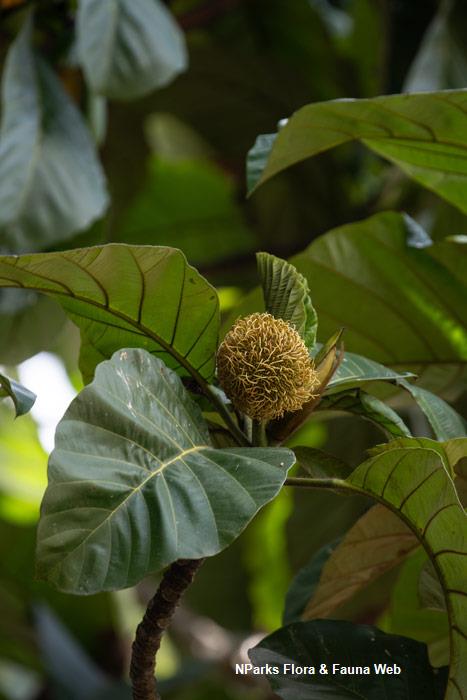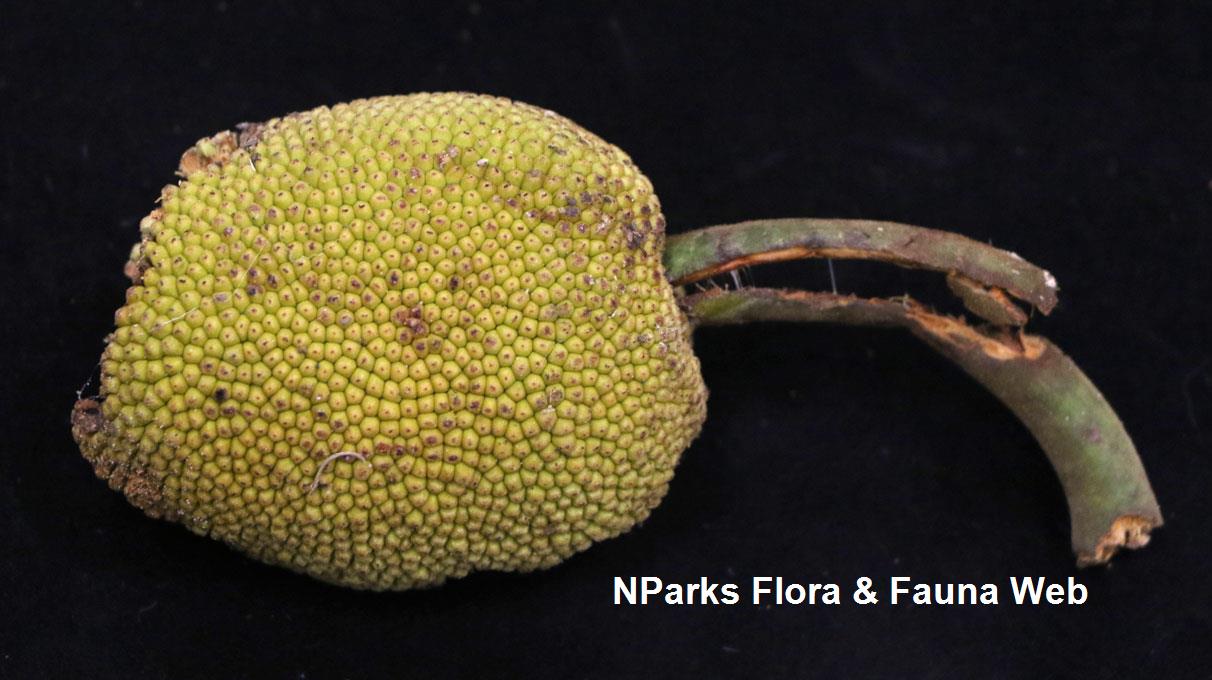_lowres.jpg)
Back
Artocarpus heterophyllus Lam.
| Family Name: | Moraceae |
| Common Name: | Jackfruit, Nangka, Jack, Jak, Jake Tree |
Artocarpus heterophyllus, also known as Jackfruit, is a tree which can reach up to 30 m tall. It produces a large composite fruit which is covered with conical warts. The aril is juicy and sweet-tasting. The seeds can be eaten after roasting or boiling.
Name
Classifications and Characteristics
| Plant Growth Form | Tree (Medium (16m-30m)) |
|---|---|
| Lifespan (in Singapore) | Perennial |
| Mode of Nutrition | Autotrophic |
| Plant Shape | Rounded |
| Tree or Palm – Trunk Diameter | 80 cm |
Biogeography
| Native Distribution | Tropical Asia |
|---|---|
| Preferred Climate Zone | Tropical |
Description and Ethnobotany
| Growth Form | Tree, monoecious, evergreen, height up to 20 m and 80 cm in diameter. Bark is rough or scaly, dark grey to greyish brown in colour. When young, crown is dense and conical but when older, it becomes rounded and spreading. |
|---|---|
| Foliage | Leaves are thin-leathery and obovate-elliptic to elliptic. The leaves are smooth on the surface and rough on the undersides. Stipules are ovate-acute, deciduous and leave ring-like form on the twigs. |
| Cultivation | Although it can grow on any different types of soil, it performs best in deep, well-drained, alluvial and sandy or loamy soils, pH 6.0-7.5. Propagated by seed- only use large seed, wash the seed thoroughly to remove the slimy coat around the seed, and remove the horny part of pericarp to improve germination. If short storage is needed, do not let it dry out and should store at an airtight container at 20°C. Germination takes place within 35 – 40 days, but if condition is suitable, it will begin as early as within 10 days. You can determine the fruit maturity by: tapping the fruit and it will produce a dull and hollow sound, the skin colour will change from pale green to greenish- or brownish-yellow, when the fruit emit a characteristic odour, and the spines will flatten and the space in between will widen. Then harvest it by cutting the stalk with a knife. As the fruit is not hardy, it is best to carefully lowered it to ground. |
| Ethnobotanical Uses | Edible Plant Parts : Edible Fruits Food (Fruit or Vegetable): When fruit is young, the pulp is used to cook as vegetable, pickled or canned in brine or curry. When fruit is ripe, it can be eaten fresh or made into various delicacies, chutney, jam, jelly and paste. It can also be preserved as candies, by mixing with sugar, honey, or syrup. Used to flavour ice cream, beverages, made into jackfruit honey or reduced to a concentrate, or power and made into drinks. After boiling or roasting, the seed can be eaten. It can also be eaten as table nut by drying it and salted. The seed can also be grounded into flour to mix with wheat flour and used for baking. (Herb or Spice) Medicinal: The jackfruit wood also has sedative properties. The jackfruit pulp and seeds are considered as a cooling and nutritious tonic and useful in overcoming the effects of alcohol. The starch from the seed is used to relieve bilious. Heated leaves can be used to treat wounds, and the ash, when burned with maize and coconut shell can treat ulcers. By mixing vinegar and latex, it can promotes healing of abscesses, snakebite and glandular swellings. In the treatment against skin diseases and asthma, the root is used. Its extraction is used to treat fever and diarrhea. Timber & Products: From the wood particles, a yellow dye is extracted and used to dye silk and cotton robes. Classified as medium hardwood, resistant to termite attack, fungal and bacterial decay, the timber is considered superior to teak, though not as hard as teak, for furniture, construction, turnery, masts, oars, and implements and musical instrument. It is also easy to season and take polish beautifully. |
Landscaping Features
| Landscape Uses | General |
|---|---|
| Thematic Landscaping | Economic Garden |
Plant Care and Propagation
| Light Preference | Full Sun |
|---|---|
| Water Preference | Moderate Water |
| Plant Growth Rate | Moderate |
| Rootzone Tolerance | Fertile Loamy Soils, Well-Drained Soils |
| Propagation Method | Seed |
Foliar
| Foliage Retention | Evergreen |
|---|---|
| Mature Foliage Colour(s) | Green |
| Mature Foliage Texture(s) | Leathery, Thin |
| Foliar Shape(s) | Non-Palm Foliage (Obovate, Elliptical) |
| Foliar Apex - Tip | Acute |
| Leaf Area Index (LAI) for Green Plot Ratio | 3.0 (Tree - Intermediate Canopy) |
Non - Foliar and Storage
| Mature Bark Texture | Scaly |
|---|
Floral (Angiosperm)
| Flower & Plant Sexuality | Unisexual Flowers , Monoecious |
Image Repository
Others
| Master ID | 1440 |
|---|---|
| Species ID | 2733 |
| Flora Disclaimer | The information in this website has been compiled from reliable sources, such as reference works on medicinal plants. It is not a substitute for medical advice or treatment and NParks does not purport to provide any medical advice. Readers should always consult his/her physician before using or consuming a plant for medicinal purposes. |


.jpg)
.jpg)









_lowres.jpg)
_lowres.jpg)

